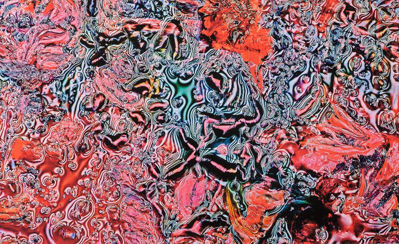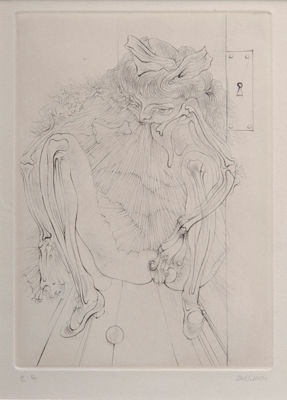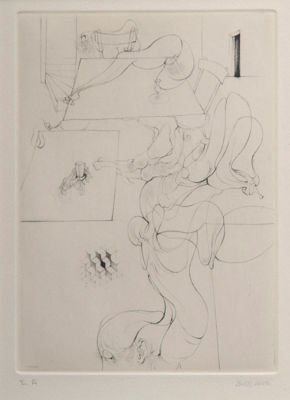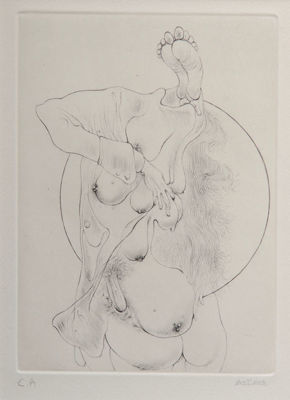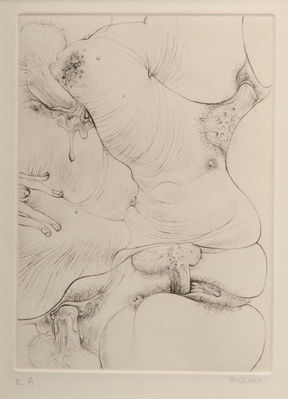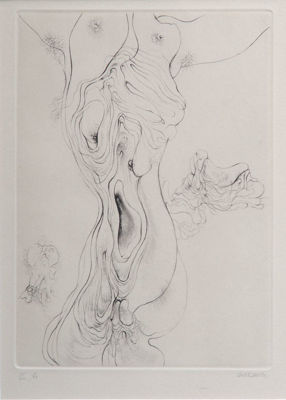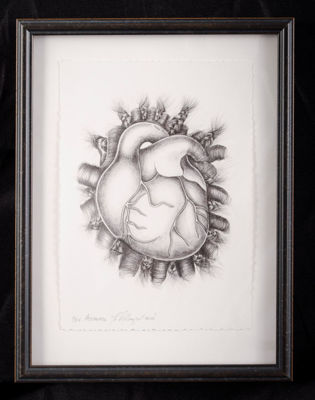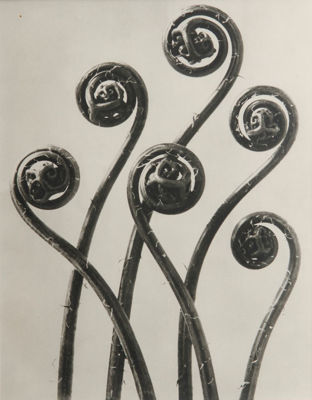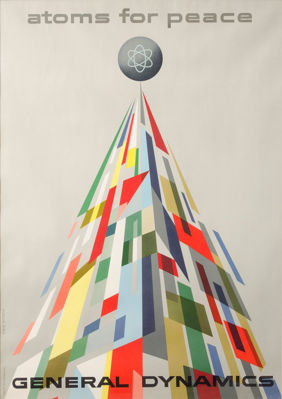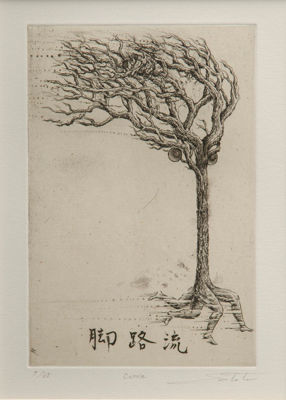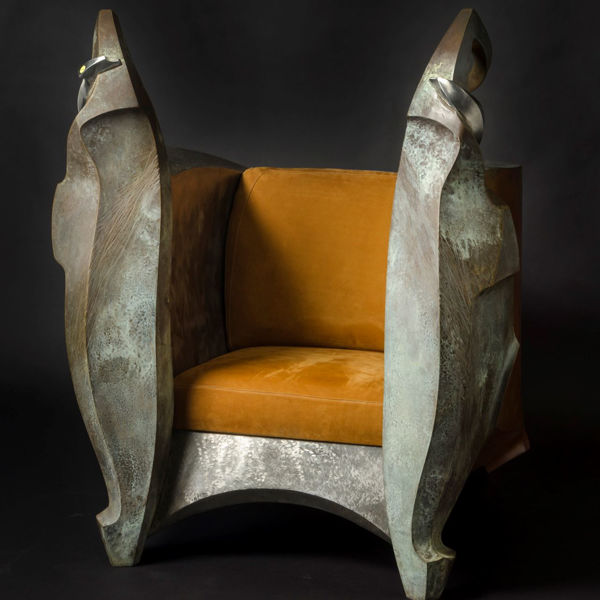Photography and Prints
Title: A Face of Drops
Sakura’s figures, usually displayed under a series of female names, blend personalities with the style and shape of a natural form — the combination returning a surreal and shrouded portrait with allegories to folk or fantasy. The intaglio-printed tree form of ‘Carole’ is one of Sakura’s more whimsical creations, the bulging eyes and dashing feet looping into a lineage of character storytelling from Japanese anime to the fables that inspired them, the artist playfully exercising a sense of motion that allows a particularly compelling visual description — the branches whipping backwards and feet blurring in their hurry.
Title: A Sade
One of a series of 10 erotic sketches, produced late in Bellmer’s career as an artist but typical of his post-war production that moved away from sculptural dolls and towards more explicit pornographic imagery and 2d representation. ‘A Sade’ is loosely inspired by Marquis de Sade and Bellmer’s admiration for the acts of violence in conjunction with desire committed by the noble, the plates commonly depicting faceless masses writhing in an orgiastic, polymorphic combination; genitalia often the only common representational reference within the twisting shapes conjured in delicate drawing.
Title: A Sade
A series of 10 erotic sketches, produced late in Bellmer’s career as an artist but typical of his post-war production that moved away from sculptural dolls and towards more explicit pornographic imagery and 2d representation. ‘A Sade’ is loosely inspired by Marquis de Sade and Bellmer’s admiration for the acts of violence in conjunction with desire committed by the noble, the plates commonly depicting faceless masses writhing in an orgiastic, polymorphic combination; genitalia often the only common representational reference within the twisting shapes conjured in delicate drawing. Ten etchings (framed separately); Each signed and noted E.A.; 7 3/4" x 5 1/2" (plate,each); 8 7/8" x 6 3/8" (sight, each); Provenance: Lerner-Misrachi Gallery, New York; Estate of Ronald K. De Long, Pennsylvania
Title: A Sade
A series of 10 erotic sketches, produced late in Bellmer’s career as an artist but typical of his post-war production that moved away from sculptural dolls and towards more explicit pornographic imagery and 2d representation. ‘A Sade’ is loosely inspired by Marquis de Sade and Bellmer’s admiration for the acts of violence in conjunction with desire committed by the noble, the plates commonly depicting faceless masses writhing in an orgiastic, polymorphic combination; genitalia often the only common representational reference within the twisting shapes conjured in delicate drawing. Ten etchings (framed separately); Each signed and noted E.A.; 7 3/4" x 5 1/2" (plate,each); 8 7/8" x 6 3/8" (sight, each); Provenance: Lerner-Misrachi Gallery, New York; Estate of Ronald K. De Long, Pennsylvania
Title: A Sade
One of a series of 10 erotic sketches, produced late in Bellmer’s career as an artist but typical of his post-war production that moved away from sculptural dolls and towards more explicit pornographic imagery and 2d representation. ‘A Sade’ is loosely inspired by Marquis de Sade and Bellmer’s admiration for the acts of violence in conjunction with desire committed by the noble, the plates commonly depicting faceless masses writhing in an orgiastic, polymorphic combination; genitalia often the only common representational reference within the twisting shapes conjured in delicate drawing. Ten etchings (framed separately); Each signed and noted E.A.; 7 3/4" x 5 1/2" (plate,each); 8 7/8" x 6 3/8" (sight, each); Provenance: Lerner-Misrachi Gallery, New York; Estate of Ronald K. De Long, Pennsylvania
Title: A Sade
A series of 10 erotic sketches, produced late in Bellmer’s career as an artist but typical of his post-war production that moved away from sculptural dolls and towards more explicit pornographic imagery and 2d representation. ‘A Sade’ is loosely inspired by Marquis de Sade and Bellmer’s admiration for the acts of violence in conjunction with desire committed by the noble, the plates commonly depicting faceless masses writhing in an orgiastic, polymorphic combination; genitalia often the only common representational reference within the twisting shapes conjured in delicate drawing. Ten etchings (framed separately); Each signed and noted E.A.; 7 3/4" x 5 1/2" (plate,each); 8 7/8" x 6 3/8" (sight, each); Provenance: Lerner-Misrachi Gallery, New York; Estate of Ronald K. De Long, Pennsylvania
Title: A Sade
A series of 10 erotic sketches, produced late in Bellmer’s career as an artist but typical of his post-war production that moved away from sculptural dolls and towards more explicit pornographic imagery and 2d representation. ‘A Sade’ is loosely inspired by Marquis de Sade and Bellmer’s admiration for the acts of violence in conjunction with desire committed by the noble, the plates commonly depicting faceless masses writhing in an orgiastic, polymorphic combination; genitalia often the only common representational reference within the twisting shapes conjured in delicate drawing. Ten etchings (framed separately); Each signed and noted E.A.; 7 3/4" x 5 1/2" (plate,each); 8 7/8" x 6 3/8" (sight, each); Provenance: Lerner-Misrachi Gallery, New York; Estate of Ronald K. De Long, Pennsylvania
Title: A Sade
A series of 10 erotic sketches, produced late in Bellmer’s career as an artist but typical of his post-war production that moved away from sculptural dolls and towards more explicit pornographic imagery and 2d representation. ‘A Sade’ is loosely inspired by Marquis de Sade and Bellmer’s admiration for the acts of violence in conjunction with desire committed by the noble, the plates commonly depicting faceless masses writhing in an orgiastic, polymorphic combination; genitalia often the only common representational reference within the twisting shapes conjured in delicate drawing. Ten etchings (framed separately); Each signed and noted E.A.; 7 3/4" x 5 1/2" (plate,each); 8 7/8" x 6 3/8" (sight, each); Provenance: Lerner-Misrachi Gallery, New York; Estate of Ronald K. De Long, Pennsylvania
Title: A Sade
A series of 10 erotic sketches, produced late in Bellmer’s career as an artist but typical of his post-war production that moved away from sculptural dolls and towards more explicit pornographic imagery and 2d representation. ‘A Sade’ is loosely inspired by Marquis de Sade and Bellmer’s admiration for the acts of violence in conjunction with desire committed by the noble, the plates commonly depicting faceless masses writhing in an orgiastic, polymorphic combination; genitalia often the only common representational reference within the twisting shapes conjured in delicate drawing. Ten etchings (framed separately); Each signed and noted E.A.; 7 3/4" x 5 1/2" (plate,each); 8 7/8" x 6 3/8" (sight, each); Provenance: Lerner-Misrachi Gallery, New York; Estate of Ronald K. De Long, Pennsylvania
Title: A Sade
A series of 10 erotic sketches, produced late in Bellmer’s career as an artist but typical of his post-war production that moved away from sculptural dolls and towards more explicit pornographic imagery and 2d representation. ‘A Sade’ is loosely inspired by Marquis de Sade and Bellmer’s admiration for the acts of violence in conjunction with desire committed by the noble, the plates commonly depicting faceless masses writhing in an orgiastic, polymorphic combination; genitalia often the only common representational reference within the twisting shapes conjured in delicate drawing. Ten etchings (framed separately); Each signed and noted E.A.; 7 3/4" x 5 1/2" (plate,each); 8 7/8" x 6 3/8" (sight, each); Provenance: Lerner-Misrachi Gallery, New York; Estate of Ronald K. De Long, Pennsylvania
Title: A Sade
A series of 10 erotic sketches, produced late in Bellmer’s career as an artist but typical of his post-war production that moved away from sculptural dolls and towards more explicit pornographic imagery and 2d representation. ‘A Sade’ is loosely inspired by Marquis de Sade and Bellmer’s admiration for the acts of violence in conjunction with desire committed by the noble, the plates commonly depicting faceless masses writhing in an orgiastic, polymorphic combination; genitalia often the only common representational reference within the twisting shapes conjured in delicate drawing.
Title: Al Green and Ann Nesby
Al Green and Ann Nesby Mayy 18th, 2002, 8:00 Tower Theater
Title: Alison No. 2
Via Intaglio print, Japanese artist Sakura wrests for portraits that combine a strange and shaded fantasy with adroit technical skill. “Alison 2”s human physiognomy is countered by an overall fruit-like appearance, creating a vying of familiar and surreal that gives the work a mysterious and dark underpinning. Sakura inserts a dramatic level of textural detail into the grain of the flesh and leaves through a painstaking process of thin scratches with a needle into the copper printing plate, the process inducing a state of deep, vague and meditative thought which often transitions into the realisation of the result.
Title: Atoms par le Pace 10547
Nitsche was a pioneer in the design of books, annual reports, and other printed material that relied on meticulous attention to the details of page composition, the elegance of simple type presentation, and the juxtaposition of elements on a page. His hallmarks were impeccably clear design, brilliant colors, smart typography, and an adherence to particular geometric foundations. Nitsche is best known for his historic relationship with the engineering company General Dynamics. He designed a breakthrough series of posters, in addition to designing their corporate image, annual reports, and advertising. He was hired as art director for General Dynamics and savored designing technical data for such things as hydraulic systems and cross-sections of airplanes.
Title: Bridge Repairs
Lozowick is renowned for his Precisionist style with his lithographs, influenced in part from his travels through Berlin and Moscow and associations with styles such as Russian Constructivism, Bauhaus, Futurism and De Stijl, and contact with artists such as El Lissitsky. The sharp, geometrically inclined murals focus heavily on the repeating forms and patterns of mechanised industry and the urban environment, but convey humanist principles and an ultimately optimistic view of industrial progression and the human condition within 1930s New York.
Title: Carole
Sakura’s figures, usually displayed under a series of female names, blend personalities with the style and shape of a natural form — the combination returning a surreal and shrouded portrait with allegories to folk or fantasy. The intaglio-printed tree form of ‘Carole’ is one of Sakura’s more whimsical creations, the bulging eyes and dashing feet looping into a lineage of character storytelling from Japanese anime to the fables that inspired them, the artist playfully exercising a sense of motion that allows a particularly compelling visual description — the branches whipping backwards and feet blurring in their hurry.
Title: Cheetah
Son of famed social realist painter George Biddle, the 1966 “Cheetah” etching belongs to an early path in the artist’s career, taking on and shifting the thematic resonance's prevalent in his father’s work to a new generation, and looking to compare such an attitude with the social and cultural upheavals of the 1960s. The representation of a shifting human mass seems particularly Boschian in its recounting, simultaneously demonizing and relishing the chaotic and debaucheries collective space, which reveals itself slowly as a rock concert caught in spotlight.

